 |
| Bar girls shout slogans in Mumbai on Friday. (Reuters) |
Mumbai, Aug. 20: Some of them had their faces partly covered, because this was the first time they were in the vicinity of television cameras.
“Barbala bhi virbala hai”, “Hame bhi jeene do,” read the placards they were carrying. The podium had the poster of a woman with her bare back facing the crowds, with a banner in front that said: “Is it obscene?”
For the first time, dance bar girls came out in public in thousands, from the far-flung suburbs of Panvel, Vashi and Thane as well as the city hotspots to protest what they called the greatest problems in their profession: policemen, especially in times of elections, and a recent government circular.
“Mera to kaam bandh honewala hai (I’ll soon have to sit idle),” said Shabbu, who works in Swaroop Palace Bar and Restaurant, Gulalwadi, carrying a poster at the Azad maidan rally that screamed the name of the bar. “I used to earn Rs 500-600 per day. Now it is barely Rs 200-300. I can barely pay my rent.”
“Customers” have stopped coming, she said, since the recent spate of raids on dance bars. “The police don’t care whether we maintain the 1.30 am deadline or not. They come in at 11.00 pm and round us up and register the time as after 1.30 am. Then we have to pay hafta.”
“It doesn’t even take care of my make-up and clothes. I spend about Rs 6,000-10,000 on cosmetics, beauty parlour and clothes,” said Shehnaaz. They are only two of the 40,000 women who work in the city’s dance bars.
The men — the bar-owners and the male staffers — too, were present in equal numbers, and in most cases did the talking as most of the women shied away from the TV cameras or even print journalists. Many blamed a recent government circular.
“The circular says there has to be a distance of 5 feet between the dancers and the customers, and that the customers can’t give money to the girls. How can a dance bar work within such restrictions?” asked a waiter from a dance bar in Panvel. “We are losing customers by the day.”
The meeting was organised by the Bar Owners’ Association, the Bar Girls’ Union of India and the Womanist Party of India, an all-woman party floated recently.
The bar-owners were the most vocal. “We pay Rs 3 lakh for liquor licence, Rs 50,000 for restaurant licence, Rs 500 to the commissioner of police per day per stage (a dance bar may have one to three platforms for performance) as licence fee and Rs 1,000 per day per stage to the collector of Mumbai,” Sohail Khan said.
“On top of it, we can’t deal with the police when they come and say that our women are in prostitution and arrest them,” he said.
Another bar-owner alleged that the police action was the usual pre-poll drive to raise money. “The ruling coalition needs funds for the Assembly elections. That is why it is instigating the police.”
“The circular issued on July 16 is the last straw,” said Manjit Singh Sethi, president, Fight for Rights of Bar Owners’ Association. “It is offensive in its language. It implies that all dance bars are hotbeds of prostitution and underworld dealings.” He claimed that 10,000 girls are picked up annually from the dance bars but have not got a single conviction.
Sethi said the dance bar industry provides an annual revenue of Rs 1,500 crore to the government, an equal amount in hafta and provides employment to 10 lakh people in Maharashtra. “The industry deserves some recognition. Instead, we are punished.”
He said the government should take note because many people will be forced on to the streets if the raids continue.
Vaishali Haldankar, a bar girl for 16 years and secretary of the Bar Girls’ Union of India, had more basic demands. “We don’t have basic social security. We want homes. If possible, identity cards,” she said.










